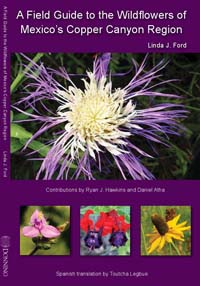Book Review: A Field Guide to the Wildflowers of Mexico's Copper Canyon Region

A Field Guide to the Wildflowers of Mexico's Copper Canyon Region
By Linda J. Ford
Spanish translation by Toutcha Lebgue
The Donning Company Publishers: 2009
ISBN-13: 978-1-57864-556-5
Paperback: $24.95 (70 percent of proceeds donated to Tarahumara scholarship fund)
Potential Readers
- Gardeners interested in drought-tolerant plants
- Horticultural hobbyists and master gardeners
- Anyone interested in Mexico's Copper Canyon lands and Tarahumara Indians
- Travelers planning a trip to Northwest Mexico
Copper Canyon is one of four labyrinthine gorges in Northwest Mexico's state of Chihuahua. The canyon lands are home to the indigenous Tarahumara Indians, who are famous for their reclusive culture, herbal knowledge and habit of easily running ultra marathon distances. Linda J. Ford, author of A Field Guide to the Wildflowers of Mexico's Copper Canyon Region, says that it would make more sense to call the 25,000-square mile area the Sierra Tarahumara.
Ford notes that the canyons contain four distinct climate zones. Starting at canyon rims 8,000 feet above sea level, these zones range from conifer forests with winter temperatures sometimes below freezing to subtropical-to-tropical riparian forests at canyon bottoms.
The gorges are home to a broad range of colorful wildflowers, including plants such as Lemmon's Sage (Salvia lemmonii), Spider Lily (Hymenocallis), Trumpetbush (Tecoma stans), Mexican Aster (Cosmos bipinnatus), and Sonoran Beardtongue (Penstemon stenophyllus). Leafing through all the color photos can make you feel like a kid in a candy shop who wants all the pretty shapes and colors.
In traditional field guide style, plants in the book are divided into color groups. To make field identification easier for users, Ford further divides these sections based on the structure of flowers and how they appear on their stems. She provides a quick, illustrated primer on understanding these subgroups and identifying different types of leaves. These features, as well as the plant descriptions, appear in Spanish as well as English.
Following retirement from her career as a psychotherapist, Ford pursued interests in horticulture and travel. She became a master gardener through the Cornell Cooperative Extension. On a trip to the Copper Canyon area one autumn, which is its peak bloom season, Ford discovered that no field guides were available for the area's abundance of native wildflowers.
Like many a plant explorer before her, Ford set out to record the floral bounty. Along the way, she fell in love with the local culture as well.
Ford's journey from backyard gardener to well-respected amateur botanist is fascinating in itself. Producing the book included three lengthy stays in the region, university classes in Spanish language and lengthy communication with botanists in the U.S. and Mexico to become familiar with plant description and scientific naming.
Copies of Ford's field guide are available through her Copper Canyon Wildflowers website and through Amazon. The author donates 70 percent of the earnings to a scholarship fund for Tarahumara students. This generosity is admirable as is the cultural sensitivity and common sense of providing the book's essential information in Spanish as well as English.

Comments
There are no comments yet.